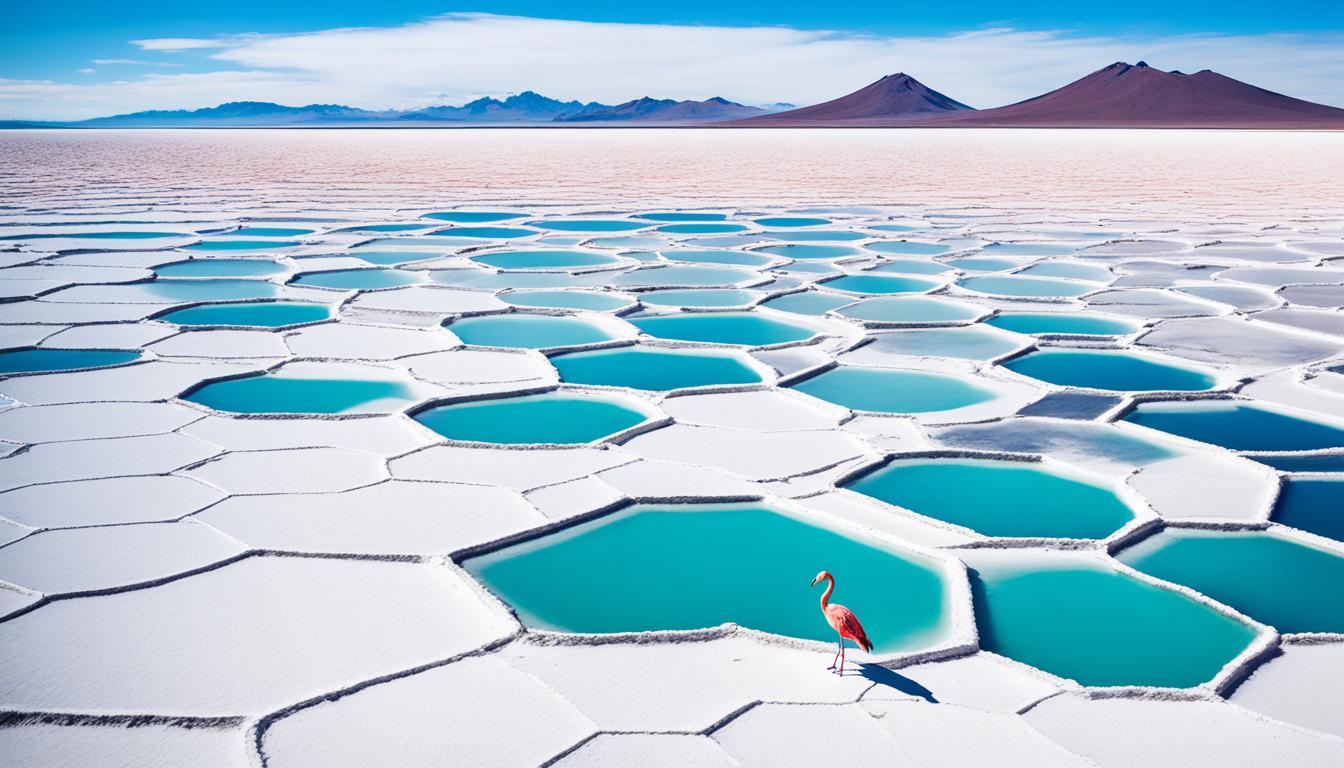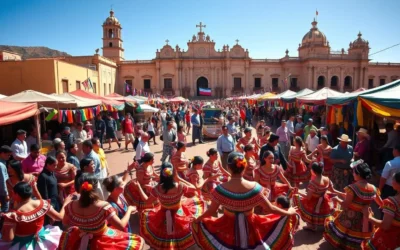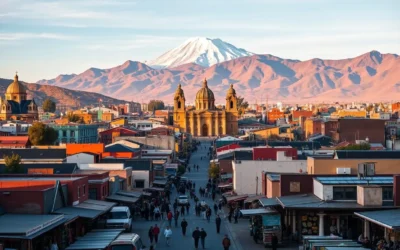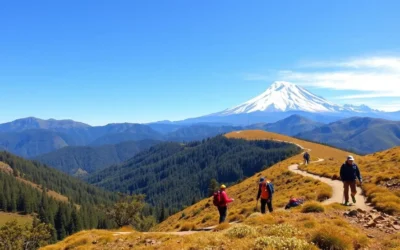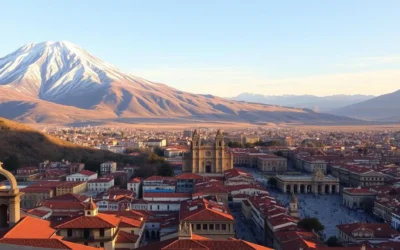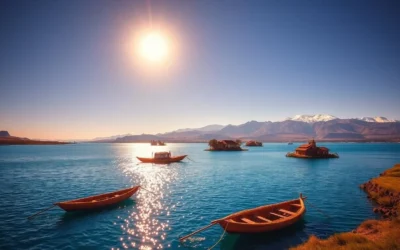✓ Accommodations ✓ Flights ✓ Rental Cars
Imagine standing on a vast, pristine white canvas – a breathtaking natural wonder that stretches as far as the eye can see. This is the Salar de Uyuni, the world’s largest salt flat. It’s located in the heart of the Bolivian Altiplano. But what secrets and surprises does this mesmerizing landscape hold? Let’s embark on an adventure and uncover the best things to do in Salar de Uyuni.
Key Takeaways
- Salar de Uyuni is the world’s largest salt flat, spanning over 10,000 square kilometers.
- Witness the stunning mirrored effect during the rainy season and explore the unique hexagonal salt patterns in the dry season.
- Discover the surreal Isla Incahuasi, home to ancient giant cacti and fossilized coral remnants.
- Marvel at the Dakar Rally Monument, a popular photography spot in Uyuni.
- Uncover the remnants of the historical Train Graveyard in Uyuni.
So, are you ready to embark on an unforgettable adventure in the Salar de Uyuni? Prepare to be captivated by its natural wonders, unique photography opportunities, and the thrill of discovering this extraordinary destination.
Exploring the Vast Salt Flats of Salar de Uyuni
The Salar de Uyuni in Bolivia is a breathtaking natural wonder. It covers over 10,500 square kilometers (4,000 square miles). This makes it the world’s largest salt flat, created from ancient lakes 40,000 years ago. It has 10 billion tons of salt and the world’s largest lithium deposit, key for electric batteries.
From December to April, the wet season brings a thin water layer, creating a mirrored effect. This lets visitors take amazing photos that play with depth and scale. Even in the dry season, the salt flats show unique polygon patterns that are visually stunning.
Witnessing the Stunning Mirrored Effect
The rainy season, from December to April, is the best time to see the Salar de Uyuni salt flats mirror-like reflection. A thin water layer makes the world’s largest natural mirror. Visitors can take surreal shots that mix earth and sky.
Capturing Mesmerizing Perspective Photography
The Salar de Uyuni salt flats are perfect for creative perspective photography. The endless white landscape and its reflection let photographers experiment with scale and depth. They can capture subjects in unique ways, from floating islands to giant figures.
Discovering the Unique Polygon Patterns
Even without water, the Salar de Uyuni salt flats are visually striking with their polygon patterns. These shapes, formed by salt evaporation over centuries, create a mesmerizing landscape. It’s a treat for the senses.
“The Salar de Uyuni is a truly awe-inspiring sight, a natural wonder that offers a multitude of visual delights for the curious traveler.”
Visiting the Surreal Isla Incahuasi
In the heart of Bolivia’s Salar de Uyuni lies Isla Incahuasi, a rocky island oasis. It’s home to giant cacti that have lived for centuries in this tough environment. Hiking here lets you see these amazing plants up close and learn about their survival skills.
Hiking Among Ancient Giant Cacti
Exploring Isla Incahuasi, you’ll see giant cacti all around. These plants, some over 6 meters tall, have survived the salt flats’ harshness. The hike lets you see these wonders up close and learn about their history.
Discovering Fossilized Coral Remnants
Isla Incahuasi also has fossilized coral. These fossils show the area’s past when it was underwater. Look for these fossils as you walk around the island to connect with its history.
Enjoying Panoramic Views of the Salt Expanse
From the island’s highest spot, you get amazing views of the Salar de Uyuni. The vast, shiny salt flats stretch far, creating a surreal scene. Take your time to enjoy these views and capture the beauty of this place.
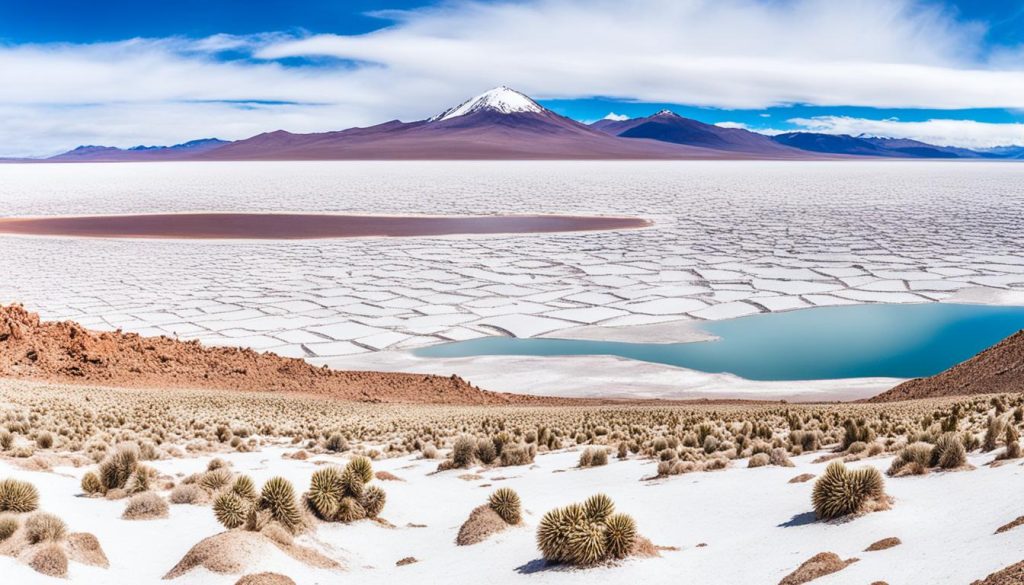
Visiting the Incahuasi (Cactus) Island costs 30 Bolivianos (about 5 USD). It’s a great spot for nature lovers, photographers, or anyone who loves the world’s natural beauty. Don’t miss it when you’re in the Salar de Uyuni.
Marveling at the Dakar Rally Monument
The Dakar Rally Monument sits in the stunning Salar de Uyuni salt flats. It honors the Dakar Rally, a tough motorsport event. This event has crossed the tough terrain here for years.
The monument is made of the salt that covers the area. Its design shows the Dakar Rally’s spirit. It has a bold shape and flags for each country, making it a great spot for motorsport enthusiasts and photography fans.
Looking at the monument, you can hear the race’s roar and feel the excitement. It shows our desire to test limits and push technology. All this in a place that’s out of this world.
“The Dakar Rally Monument is a true icon of the Salar de Uyuni, a symbol of the indomitable human spirit that fuels this extraordinary motorsport event.” – Motorsport Enthusiast Magazine
For motorsport enthusiasts or photography lovers, the monument is unforgettable. Its size and the salt flats’ beauty make it a top spot to visit in Salar de Uyuni.
Uncovering the Remnants of the Train Graveyard
A short drive from Uyuni takes you to the Train Graveyard. Here, old steam locomotives from the 19th and 20th centuries slowly decay. They stand against the stunning altiplano landscape. This place shows the mix of old machines and nature in a unique way.
Exploring the Decaying Steam Locomotives
The Train Graveyard gives a peek into Uyuni’s industrial history. As you walk through, you’ll see the detailed work and engineering of the old steam locomotives. These machines tell stories of the industrial might and growth that once drove the region.
Witnessing the Industrial Might of the Past
At the Train Graveyard, the size and power of the old locomotives are striking. These machines were built to move goods and people over long distances. Now, they stand as a reminder of history’s changes. The Train Graveyard lets you think about Uyuni’s industrial past and how the area has changed.
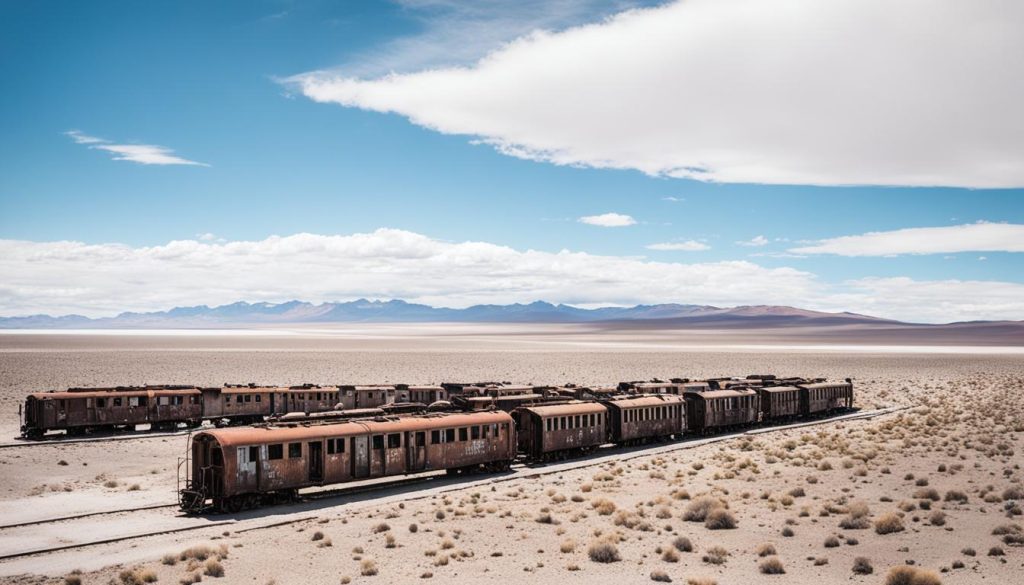
“The Train Graveyard offers a unique and thought-provoking glimpse into Uyuni’s industrial past.”
Walking through the Train Graveyard, you’ll see its haunting beauty and deep history. The old locomotives remind us of progress’s fleeting nature. They also show how nature can take back what was once its own.
Salar de Uyuni, Bolivia: Best Things to Do – Top Picks
Salar de Uyuni is Bolivia’s gem, offering amazing experiences for those who love nature. You can explore the vast salt flats and see the stunning mirrored effect. Or, you can visit the surreal Isla Incahuasi and see the old Uyuni.
This place has something for everyone, from nature lovers to photographers. Whether you’re on a long tour or making your own plan, Salar de Uyuni is a must-see. It’s the biggest salt flat in the world, as big as Hawaii’s Big Island. And it’s filled with 10 billion tonnes of salt, up to 10 meters deep in the center.
During the wet season, Salar de Uyuni turns into the world’s biggest mirror. This makes it a top spot for photographers. It’s even been in movies like Star Wars.
But there’s more to see than just the salt flats. You can visit Isla Incahuasi with its giant cacti and fossils. Or check out the Dakar Rally Monument for adventure vibes. The Train Graveyard shows Uyuni’s industrial past, and the Altiplano lagoons are full of flamingos.
For anyone who loves nature, adventure, or photography, Salar de Uyuni is unforgettable. Its unique landscapes, history, and activities make it a top spot in Bolivia.
| Statistic | Value |
|---|---|
| Size of Salar de Uyuni | 4,086 square miles (comparable to the size of Big Island, Hawaii) |
| Depth of Salt | Approximately 130 meters |
| Bolivia’s Share of World’s Lithium Resources | 85% |
| Annual Visitors to Uyuni | Around 300,000 |
| Daily Salt Extraction | 10 billion tons |
| Most Popular Tour Option | 3-day/2-night tour |
Admiring the Colorful Lagoons and Flamingos
As you explore the Bolivian Altiplano, you’ll see the stunning colors of its lagoons. Laguna Colorada is a highlight, filled with hundreds of flamingos. These birds live in the red waters, thanks to the red algae and bacteria they eat. They are surrounded by volcanoes and blue skies.
There are more lagoons in the Altiplano, each with its own special colors. You’ll see blues, greens, and reds that look like nothing on Earth. These lagoons offer a unique experience that’s truly breathtaking.
Visiting Laguna Colorada and Its Flamingo Residents
Laguna Colorada, or the “Red Lagoon,” is a spot you can’t miss in the Bolivian Altiplano. It’s a home for many flamingos, including Andean, Chilean, and James’s flamingos. They live in the red waters.
Discovering the Unique Colors of the Altiplano Lagoons
- Laguna Verde (Green Lagoon): A stunning emerald-hued lake, the result of high mineral content and a unique microbial balance.
- Laguna Blanca (White Lagoon): A serene, salt-encrusted lake that appears to be a dazzling white, contrasting beautifully with the surrounding landscape.
- Laguna Cañapa: A mesmerizing body of water that shifts in color from deep blue to vibrant green, depending on the light and weather conditions.
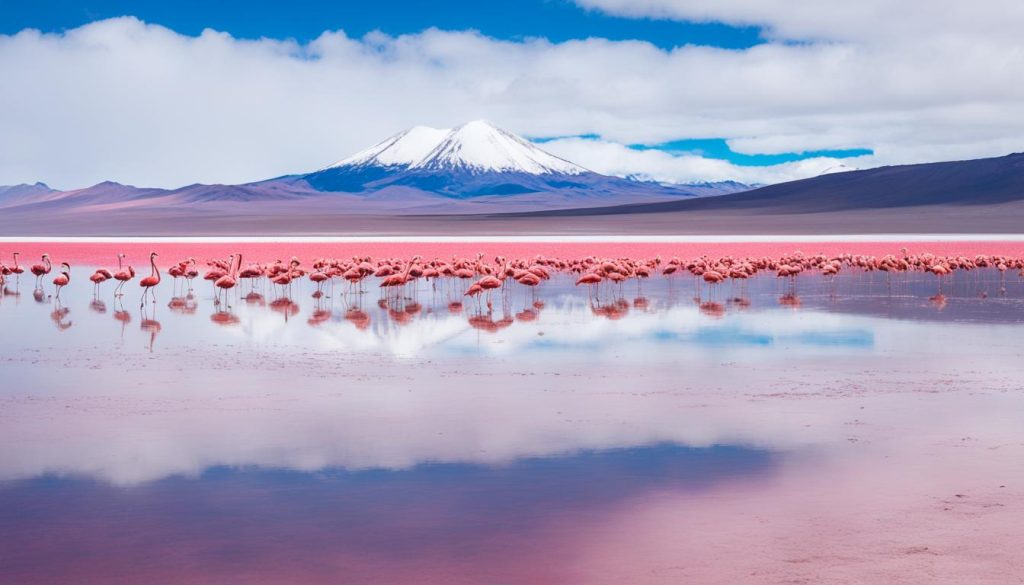
“The Altiplano’s lagoons are a truly unique and mesmerizing sight, each one a testament to the delicate balance of nature and the incredible diversity of Bolivia’s landscapes.”
Soaking in the Outdoor Hot Springs
After exploring the vast Bolivian Altiplano, travelers find peace in its outdoor hot springs. These thermal pools are heated by volcanoes. They offer a chance to relax and enjoy the beautiful views around them. The warm waters are full of minerals, helping visitors to recharge for more adventures.
The outdoor hot springs in the Bolivian Altiplano are a hidden treasure. They are perfect for relaxation in a unique setting. As you soak in the warm waters, you can watch the salt flats, mountains, and colorful lagoons. It’s a way to let go of daily stress.
If you’re looking for peace after a tough hike or want to enjoy the thermal pools, the outdoor hot springs are ideal. They offer a memorable experience. Take time to relax, enjoy the calm, and get ready for your next adventure in this amazing place.
“The warm, mineral-rich waters of the Bolivian Altiplano’s outdoor hot springs provide a truly rejuvenating experience, allowing visitors to unwind and recharge amidst the region’s stunning natural beauty.”
Witnessing the Bubbling Geysers at Sol de Mañana
In Bolivia’s high-altitude regions, the Sol de Mañana geysers are a sight to behold. They sit at about 5,000 meters high. This makes them a result of the area’s intense volcanic activity.
When you get closer, you’ll see steam and bubbling mud from the earth. The temperatures here can hit up to 90°C. This makes the scene look like something from another world.
Even with the high altitude, you might feel a bit off. But seeing the Sol de Mañana geysers is worth it. They’re a key spot in the Salar de Uyuni area. The volcanic activity here shows how amazing this place is.
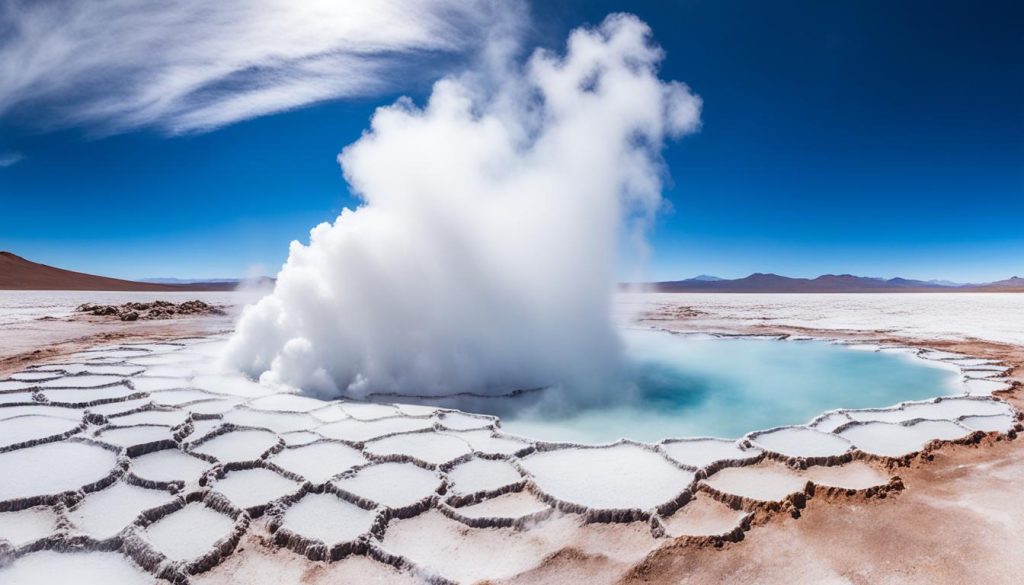
“Witnessing the powerful eruptions of the Sol de Mañana geysers is a truly humbling experience, reminding us of the incredible forces that shape our planet.”
If you love nature, photography, or just being amazed, don’t miss the Sol de Mañana geysers. They’re a highlight of the beautiful Salar de Uyuni and its high altitude landscapes.
Exploring the Salvador Dalí Desert Landscape
The Salvador Dalí Desert is in the Bolivian Altiplano. It looks like it came from the famous artist’s paintings. The desert has colorful mountains and unique rocks. It inspired Dalí’s painting “Nude in the Desert,” even though he never visited the area.
Walking through the Salvador Dalí Desert feels like a dream. It mixes reality with imagination. The views look like Dalí’s famous melting clocks and strange landscapes. It takes you to another world, just like Dalí’s art.
The desert’s colors are vibrant, with sharp contrasts and vast salt plains. You’ll see tall, colorful mountains and detailed patterns on the ground. Every part of the desert seems to defy nature’s limits.
If you like Dalí’s art or just love amazing landscapes, you must see the Salvador Dalí Desert. It’s a key stop on any Bolivian trip. Get ready for a place where the impossible happens and reality gets pushed to its limits.
Conclusion
Salar de Uyuni is the world’s largest salt flat, a place of stunning beauty. It offers many amazing experiences for travelers in Bolivia. You can see the mirror-like salt flats, the surreal Isla Incahuasi, the eerie Train Graveyard, the vibrant Altiplano lagoons, and the Salvador Dalí Desert.
This place is perfect for nature lovers, adventurers, and photographers. Its unique landscapes and rich history make it a must-see. You can marvel at the stunning reflections, hike among giant cacti, or explore Bolivia’s industrial past.
When planning your trip to Salar de Uyuni, look into tour options, places to stay, and how much it will cost. This destination is full of attractions and activities. It shows off the natural beauty and cultural heritage of Bolivia.
FAQ
What is Salar de Uyuni, and why is it a top destination in Bolivia?
What can you see and do at Salar de Uyuni?
How does the mirrored effect work at Salar de Uyuni?
What can you see and do on Isla Incahuasi?
What is the Dakar Rally Monument, and why is it a popular attraction?
What can you see at the Train Graveyard near Uyuni?
What other natural wonders can you find in the Bolivian Altiplano?
What is the Salvador Dalí Desert, and how is it connected to the renowned artist?
The above is subject to change.
Check back often to TRAVEL.COM for the latest travel tips and deals.
